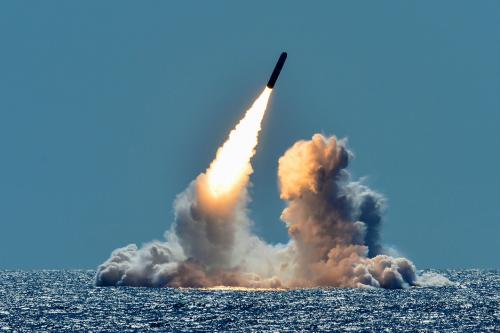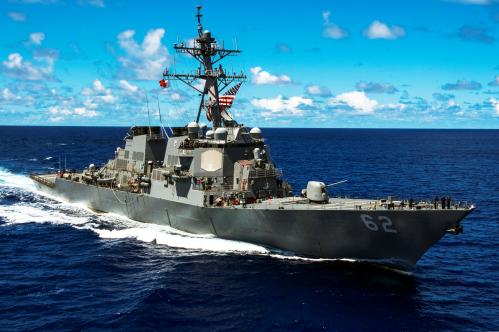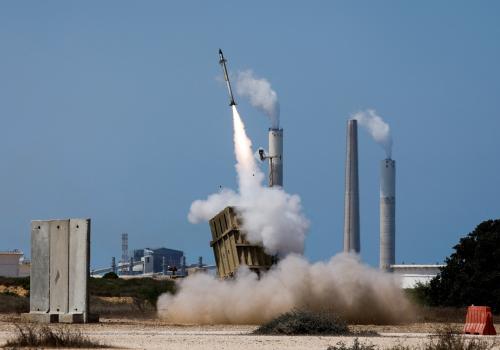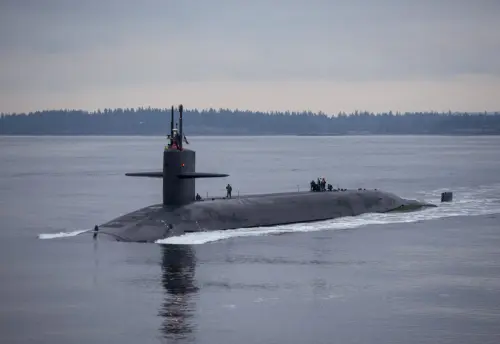The Pentagon on February 2 released the Trump administration’s nuclear posture review (NPR). The NPR describes the role the administration sees for nuclear weapons in U.S. national security policy and the specific weapons systems it believes necessary to support that posture. While it has elements of continuity with the previous review, issued in 2010 by the Obama administration, it adopts dramatically different directions on several issues.
In order to maintain a safe, secure, and effective deterrent, the United States has to modernize its strategic triad of submarine-launched ballistic missiles, intercontinental ballistic missiles, and strategic bombers as older systems age out and require replacement. However, the new directions in the Trump administration’s NPR raise questions about policy, specific systems, and affordability.
More reliance on nukes?
The numbers and types of nuclear weapons in the U.S. arsenal have declined sharply over the past 40 years. In 2010, the Obama administration adopted the explicit objective of reducing both the number and role of nuclear weapons in U.S. national security strategy. It set the goal of making the sole purpose of the U.S. nuclear arsenal the deterrence of a nuclear attack on the United States, allies, or U.S. military forces. While the Obama administration never formally adopted “sole purpose,” Vice President Biden in early 2017 stated that he and Obama believed that it should be U.S. policy.
The new NPR takes a different approach. It notes, correctly, the return of great power competition and that Russia and China have not followed the U.S. lead. They instead are increasing their reliance on nuclear arms. Like the 2010 review, the new NPR states that U.S. nuclear weapons would be used only in “extreme circumstances,” but it broadens the definition of “extreme circumstances” to include non-nuclear strategic attacks on civilian populations, infrastructure, and U.S. nuclear forces.
Is it wise for Washington to follow other nuclear powers and increase its reliance on nuclear arms? Previous presidents moved towards less reliance because they recognized the limited utility of nuclear weapons in all but the most dire of situations and saw an American comparative advantage in high-tech conventional weapons, such as precision-guided cruise missiles. It may not be smart to shift the competition to the nuclear area, where the U.S. military does not hold the same comparative advantage.
A need for smaller nukes?
Citing a gap in capabilities, the Trump NPR calls for reintroducing into the U.S. arsenal a nuclear-armed sea-launched cruise missile (SLCM) with low-yield options to provide a regional non-strategic nuclear presence. It also says the U.S. Navy will develop a low-yield warhead for some of its Trident D5 submarine-launched ballistic missiles. These are in addition to a new nuclear-armed air-launched cruise missile, the LRSO, which also will have low-yield options.
The NPR justifies the decision to add new low-yield weapons in large part by reference to Russia. It expresses concern that Russia’s panoply of non-strategic nuclear weapons with low yields could give it a coercive advantage in a crisis and lower the threshold for nuclear use. The answer it suggests is to build more U.S. low-yield nuclear weapons, apparently because they could demonstrate to Moscow a greater U.S. readiness to resort to nuclear arms in a conflict. That seems to contradict the statement early in the NPR that “In no way does this approach [outlined in the review] lower the nuclear threshold.”
Getting into a competition in low-yield nuclear arms runs the risk of inadvertently signaling that use of low-yield non-strategic nuclear weapons would be seen as different from strategic nuclear arms and somehow might be acceptable. However, it is profoundly in the American interest that, in a conflict, nuclear weapons not be used. It would be wiser to seek to raise the threshold for nuclear use—to make clear to potential adversaries that a nuclear weapon is a nuclear weapon, no matter what its size, and that any nuclear use would fundamentally change the rules of the game, immediately opening a Pandora’s box full of unpredictable, nasty, and potentially catastrophic consequences.
It is profoundly in the American interest that, in a conflict, nuclear weapons not be used.
Questions about new nukes
The new weapons noted in the Trump NPR raise particular questions. Begin with the LRSO. The U.S. Air Force first deployed nuclear-armed air-launched cruise missiles in the 1980s out of concern that B-52 bombers could not penetrate sophisticated Soviet air defenses to deliver gravity bombs. The Trump administration has reaffirmed the Obama administration’s decision to produce the B-21 bomber, which will have advanced stealth and electronic warfare capabilities. If those capabilities live up to their billing, the B-21 should be able to operate against and defeat sophisticated air defenses, making the LRSO redundant. The most compelling argument that LRSO advocates seem to muster is that they doubt the B-21 will deliver its advertised performance.
It is not apparent what regional security problem a nuclear-armed SLCM would solve. The United States already has the ability to forward deploy dual-capable aircraft—soon to include the stealthy F-35—that can deliver nuclear gravity bombs as well as conventional weapons. In the not-too-distant future, the bombs will include the B61-12, which will have low-yield options. And the U.S. Air Force regularly demonstrates its ability to forward deploy nuclear-capable bombers to regions around the world.
While submarine-launched ballistic missiles have traditionally been regarded as strategic, the new NPR describes the low-yield Trident D5 warhead as bolstering U.S. regional non-strategic nuclear capabilities. But this concept prompts questions. First, could a Trident D5 launch be misinterpreted? It would not be clear that the warhead is “small” until it detonated over target. Second, a U.S. ballistic missile submarine can carry 20 Trident missiles, typically with a total of 80 to 100 nuclear warheads, a sizeable part of the U.S. strategic deterrent. The reason the United States maintains such a large portion of its nuclear warheads on submarines is that they are hard to find and thus survivable. However, a submarine firing one Trident missile to deliver a low-yield warhead would reveal its location. Would the U.S. Navy want to risk that?
Affordability
The Congressional Budget Office estimated the cost of the Obama nuclear program at $400 billion over the next 10 years. Officials in Obama’s Defense Department candidly admitted that they had no idea where they would find the money—and that was without the additional nuclear arms that the Trump administration plans to build.
Implementing the NPR—even making the very unrealistic assumption of no major cost overruns—will prove extremely expensive.
The new NPR claims it needs only 6.4 percent of the Defense Department’s annual budget. That is a nice talking point but by itself not very meaningful. The F-35 program will likely cost $700 to $800 billion over its lifetime. Spread over 50 years, that is only 2 to 3 percent of the Pentagon’s annual budget. The problem is that these small percentages have a pesky habit of adding up to more than what Congress is prepared to spend on defense.
Implementing the NPR—even making the very unrealistic assumption of no major cost overruns—will prove extremely expensive. It will entail significant opportunity costs in the form of less money for conventional force readiness, destroyers, and attack submarines, additional soldiers and so on. As one senior Pentagon official reportedly said: “What the NPR is recommending will break the bank.”
The United States has to modernize its nuclear deterrent. It should do so prudently, however. The U.S. nuclear posture should avoid steps that could increase the chance of nuclear use, would add redundant and unneeded nuclear weapons, and would prove unaffordable or hollow out U.S. conventional forces. Congress and others should bear such questions in mind as they take a careful look at the NPR, its recommendations and its potential impact.
The Brookings Institution is committed to quality, independence, and impact.
We are supported by a diverse array of funders. In line with our values and policies, each Brookings publication represents the sole views of its author(s).





![An aerial view of the Pentagon building in Washington, June 15, 2005. [U.S. Defense Secretary Donald Rumsfeld defended the Guantanamo prison against critics who want it closed by saying U.S. taxpayers have a big financial stake in it and no other facility could replace it at a Pentagon briefing on Tuesday.] - RTXNK0I](https://www.brookings.edu/wp-content/uploads/2016/09/pentagon002-e1473173020271.jpg?quality=75&w=500)



Commentary
Questions about the Nuclear Posture Review
February 5, 2018